#FTS antenna
Text
An Introduction to Jammers

Interference causes disturbance in wireless communication. Jamming an antenna is all about interference with wireless communications. A jammer antenna is a kind of antenna used in creating interference with radio signals or noise. This interference is created to stop the battle of the antennas.
A military jammer antenna is used to radiate interference in the signals of the opponent’s radar. It also blocks the receiver’s signals with higher levels of energy signals. In this blog, we will discuss jammer, how it works, its benefits, and the special features of jammer antenna.
What is Jammer?
We discussed a few things in the above section related to jammers. Now, let us have a detailed study on the jammer. A jammer is a kind of device that helps to block signals from reaching someone. Jammers come in various types such as cell phone jammers, handheld jammers, or radar jammers.
This device is used in several electronics and communication devices. There are different kinds of jamming used for various purposes. From cell phones to GPS receivers, jammers are widely used in many devices.
Different kinds of jammers
Jammers come in different types. It is necessary to know the different kinds of jammers to know their functions and benefits. Read on to know the various kinds of jammers to understand their features:
1. GPS jammers
GPS jammer is a special kind of Jammer Antenna that helps to stop the transmission of location tracking service. It comes in different shapes and sizes. GPS jammer is a kind of standalone jammer that is very small. However, a GPS jammer can work only in a small area. It cannot be used for large vehicles.
2. Cellphone jammers
The next kind of jammer is a cellphone jammer. It can be used in blocking signals of every mobile phone. Cellphone jammers stop different frequency bands like CDMA, 3G, GSM, and 4G. Cellphone jammers come in small or large sizes. Short-range jammers are very small whereas larger jammers are very powerful and high-end models.
3. Internet jammers
Internet jammers can stop the transmission of devices with internet service. You can use an internet jammer in Wi-Fi routers and Bluetooth. It is one of the safest jammers to use in different internet-like devices to stop transmission. Moreover, these jammers protect your data from hackers and maintain its privacy as well.
Types of jamming techniques
Jamming techniques are of 2 kinds namely noise techniques and repeater techniques. Some of the most popular types of noise techniques include sweep jamming, spot jamming, and barrage jamming. On the other hand, DRFM jamming is a type of repeater jamming. Let us have a look at the types of different jamming techniques in detail:
A. Noise Techniques
Under noise techniques, there are 3 kinds of jamming techniques such as:
Spot jamming
Spot jamming is a type of noise technique in which the jammer focuses all power on a single frequency blocking the signals of frequency-agile radar.
Barrage jamming
The next jamming technique in a high jammer antenna is barrage jamming. It is a technique of jamming many frequencies with one jammer. Barrage jamming is not as powerful as other kinds of jamming techniques.
Sweep techniques
Another type of noise technique in an anti-jammer antenna is the sweep technique. It is a process of shifting the power of jammers from one frequency to another. It can jam multiple frequencies speedily at different times.
B. Digital Frequency Radio memory or DFRM
This is a kind of repeater technique that alters and re-transmits received radar energy. It is used widely in different kinds of jamming antennas.
Benefits of using jammers
A jammer is a kind of device that blocks signals in the opponent’s signals. It comes in different shapes, sizes, and patterns. Some of the major benefits of military manpack jammer antenna are as under:
1. Protection from location tracking
One of the biggest problems at different places is location tracking. We cannot avoid the problem of location tracking quite often. GPS tracks your location every time. During these times, you can use a jammer and block signals. It can effectively stop GPS transmission and protect your data from hackers.
2. Good for banks and educational institutions
Today, a jammer is used in many educational and financial institutions. It can stop cheaters and hackers to hack your data. Jammers also jam signals and protect data.
3. Stop spying and bugging attempts
Another benefit of using a jammer in the Yagi antenna is that it stops spying and bugging attempts. You can stop someone from snooping by attaching a jammer in a UHF antenna. Jammers are simple to use for FTS antenna and different types of antennas. They are also cost-effective and help to block the bug’s receiver and prevent it from getting commands.
4. Reduce the use of cellphones
Jammers are widely used in prison to reduce the use of cell phones. They are attached to the Vhf antenna at many places. Cellphone jammers in High Gain ATC Antenna help to reduce unwanted mobile calls. They also reduce illegal activities by reducing cellphone calls.
Things to consider while buying a jammer
While purchasing a jammer for High Gain Helical Antenna, you must keep in mind certain things such as:
Size
The first thing to look at while buying a jammer is the size. If you want a jammer for a small area, choose cellphone jammers. On the other hand, you must pick the desktop models if you want to jam the signals for a long time in a larger area.
Cost of jammer
The next thing to look at while buying a jammer is the cost. Cheap jammers can block mobile phone signals. They work on batteries and cost between $30 and $60. Apart from that, the cheap jammers will also cover a small area.
If you want a high-quality jammer, choose pro models. These jammers cost around $500 and can block every type of signal such as Radio communication, Cellular, and so on.
Installation
Some jammers come assembled while some jammers contain accessories to assemble. You can choose any jammer according to your need.
#jammer antenna#high jammer antenna#anti jammer antenna#military manpack jammer antenna#Yagi antenna#FTS antenna#High Gain ATC Antenna
1 note
·
View note
Text
I bought this Yaesu FT-897 as a gift to myself for passing the General Class exam last month. I was going to buy an antenna but decided to make one myself to learn more about them, so I made a field expedient, 1/4 wave end-fed. I had gooten into amateur radio with my dad who became a silent key nearly three years ago. After hearing the radio crackle to life with the sounds of a 40 meter net I forgot about how I wouldn't be able to use it on all amateur bands (because it's a Japanese model), and I wanted to run and tell my dad all about it. I wanted to throw my call out but I figured I'd better just listen for now. I was as excited as a boy on Christmas.
#amateur radio#ham radio#kf4rws#mine#radio communications#ft-897#mars mod#yaesu#40 meters#hf net#antenna
3 notes
·
View notes
Text
Round 1 - Phylum Arthropoda

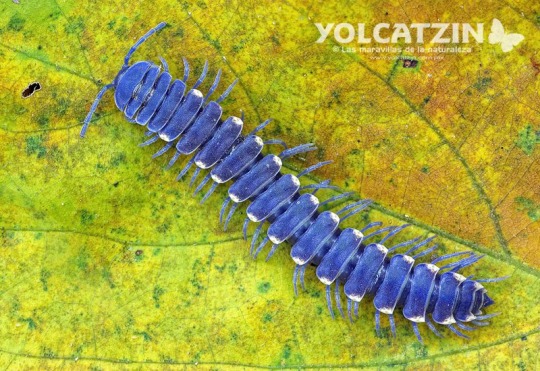


(Sources - 1, 2, 3, 4)
Arthropoda is a phylum of animals that have segmented bodies, possess a chitin exoskeleton, and have paired segmented appendages. They are colloquially called “bugs” though this is often only used for terrestrial arthropods, and sometimes only used for insects specifically.
After Nematoda, this is the most successful phylum, and it is far more diverse, with up to 10 million species! Arthropods account for 80% of all known living animal species. The three major subphyla include the Chelicerates (sea spiders, horseshoe crabs, arachnids, and the extinct eurypterids and chasmataspidids), the Myriapods (centipedes and millipedes), and the Crustaceans (shrimps, prawns, crabs, lobsters, crayfish, seed shrimp, branchiopods, fish lice, krill, remipedes, isopods, barnacles, copepods, opossum shrimps, amphipods, mantis shrimp, entognaths, and insects).
Arthropods are so diverse in fact that it is next to impossible for me to describe a model arthropod. They are important members of marine, freshwater, land, and air ecosystems and are one of only two major animal groups that have adapted to life in dry environments, the others being chordates. All arthropods have an exoskeleton and must molt as they grow, replacing their exoskeleton. Some arthropods go through a metamorphosis in this process. They have brains, a heart, and blood (called hemolymph, though some crustaceans and insects also use hemoglobin). They sense the world through small hairs called setae which are sensitive to vibration, air currents, and even chemicles in the air or water. Pressure sensors function similarly to eardrums. Antennae monitor humidity, moisture, temperature, sound, smell, and/or taste, depending on species. Most arthropods have sophisticated visual systems ranging from simple eyes (ocelli) which orient towards light, to compound eyes consisting of fifteen to several thousand independent ommatidia capable of forming images, detecting fast movement, or even seeing polarized or ultra-violet light. Some arthropods are hermaphroditic, some have more than two sexes, some reproduce by parthenogenesis, some by internal fertilization, some by external, some have complex courtship rituals, some lay eggs, some give live birth, some have prolonged maternal care. The first arthropods are known from the Ediacaran, before the Cambrian era.

Propaganda below the cut:
Insects are the first animals to have achieved flight
The smallest arthropods are the parasitic crustaceans of the class Tantulocarida, some of which are less than 100 micrometres long. The largest arthropod is the Japanese Spider Crab (Macrocheira kaempferi) with a legspan of up to 4 metres (13 ft) long. The heaviest is the American Lobster (Homarus americanus), which can get up to 20 kilograms (44 lb).
Many arthropods are popular pets, including various species of crab, shrimp, isopod, crayfish, mantis shrimp, millipede, centipede, tarantula, true spider, scorpion, amblypygid, vinegaroon, mantis, cockroach, beetle, moth, and ant! Some are even domesticated, including silk moths and honeybees.
Many arthropods are eaten by humans as a delicacy, and farming insects for food is considered more sustainable than farming large chordates. These farmed arthropods are referred to as “minilivestock.”
Arthropods feature in a variety of ways in biomimicry: humans imitating elements of nature. For example, the cooling system of termite mounds has been imitated in architecture, and the internal structure of the dactyl clubs of mantis shrimp have been imitated to create more damage tolerant materials.
Spider venoms are being studied as a less harmful alternative to chemical pesticides, as they are deadly to insects but the great majority are harmless to vertebrates. They have also been studied and could have uses in treating cardiac arrhythmia, muscular dystrophy, glioma, Alzheimer's disease, strokes, and erectile dysfunction.
Shellac is a resin secreted by the female Lac Bug (Kerria lacca) on trees in the forests of India and Thailand. It is used as a brush-on colorant, food glaze, natural primer, sanding sealant, tannin-blocker, odour-blocker, stain, and high-gloss varnish. It was once used in electrical applications as an insulator, and was used to make phonograph and gramophone records until it was replaced by vinyl.
One of the biggest ecosystem services arthropods provide for humans is pollination. Crops where pollinator insects are essential include brazil nuts, cocoa beans, and fruits including kiwi, melons, and pumpkins. Crops where pollinator insects provide 40-90% of pollination include avocados, nuts like cashews and almonds, and fruits like apples, apricots, blueberries, cherries, mangoes, peaches, plums, pears, and raspberries. In crops where pollinators are not essential they still increase production and yield. Important pollinators include bees, flies, wasps, butterflies, and moths.
Many arthropods are sacred to humans. In Ancient Egypt, scarab beetles were used in art, religious ceremonies, and funerary practices, and were represented by the god Khepri. Bees supposedly grew from the tears of the sun god Ra, spilled across the desert sand. The goddess of healing venomous bites and stings, Serket, was depicted as a scorpion. Kalahari Desert's San People tell of a legendary hero, Mantis, who asked a bee to guide him to find the purpose of life. When the bee became weary from their search, he left the mantis on a floating flower, and planted a seed within him before passing from his exhaustion. The first human was born from this seed. In Akan folklore, the cunning trickster figure Anansi/Ananse is depicted as a spider. Western astrology uses the crab constellation, called Cancer, and the scorpion constellation, called Scorpio. Dragonflies symbolize pure water in Navajo tradition. In Anishinaabe culture, dreamcatchers are meant to represent spiderwebs and are used as a protective charm for infants. They originate from the Spider Grandmother, who takes care of the children and the people of the land in many Native American cultures. The Moche people of ancient Peru often depicted spiders and crabs in their art. In an Ancient Greek hymn, Eos, the goddess of the dawn, requests of Zeus to let her lover Tithonus live forever as an immortal. Tithonus became immortal, but not ageless, and eventually became so small, old, and shriveled that he turned into the first cicada. Another hymn sings of the Thriae, a trinity of Aegean bee nymphs. Native Athenians wore golden grasshopper brooches to symbolize that they were of pure, Athenian lineage. In an Ancient Sumerian poem, a fly helps the goddess Inanna when her husband Dumuzid is being chased by galla demons. In Japanese culture, butterflies carry many meanings, from being the souls of humans to symbols of youth to guides into the afterlife. Ancient Romans also believed that butterflies were the souls of the dead. Some of the Nagas of Manipur claim ancestry from a butterfly. Many cultures use the butterfly as a symbol of rebirth. And the list goes on…
cute crab eat a strawbebby:

#round 1#animal polls#listen narrowing it down to just 4 images almost killed me#if arthropods don’t move on to round 2 I will have to take like an extra week off to mourn that I can’t show you all the cool bugs#there’s so many cool bugs guys#i chose the orchid mantis over a trilobite beetle and a poofy little bee fly cause I figured it had broader appeal#and used a horseshoe crab instead of a spider cause people are so Weird about spiders I worried it would impact the numbers#sigh#anyway I’m really hoping for Chordata Arthropoda Mollusca as top three#other phyla are all great but these three would make for the most interesting Round 2 imo
234 notes
·
View notes
Text
Melixie

Image © Paizo Publishing, presumably, accessed here
[The melixie is in the Bestiary 3, but doesn't have art in that source, being one of three monsters in a two-page spread. @abominationimperatrix found this art for me on a Ukranian Pathfinder blog, and it's definitely PF house style, which makes me wonder if it was posted by the artist somewhere. Anyway, melixies are cute and fun, and I would love to use them in a low level game sometime]
Melixie
CR ½ CN Fey
This tiny humanoid has the features of a bee—antennae, solid colored eyes without pupils, and chitin over its arms and legs. They buzz about on two pairs of translucent wings.
Melixies are fey creatures with the features of pollinating insects. Bees are the most common, but melixies resembling butterflies, moths, hoverflies and even beetles or thrips are not unheard of. They have an insatiable sweet tooth, and their diet is predominately sugar based. If a melixie can resist consuming their raw ingredients, they can use them to make tiny candies, baked goods and other deserts. Melixie confectionary is famous for both its variety and quality, and some discerning gourmets keep a melixie chef on hand for making treats that both taste great and are less filling.
Melixies believe in working hard, playing hard, and resting hard. They are willing to do even repetitive labor that other fey scoff at, as long as they are properly provisioned with sweets. Consuming a large portion (for their tiny bodies) grants them a burst of energy, allowing them to move exceptionally fast for a brief period before needing to rest and recover. Melixies often use this ability if they are in combat, letting them make hit and run attacks with their acid splashes and stingers (all melixies have a short retractable sting, regardless of the specific insect they resemble). Melixies get along well with arthropods of all kinds. Many melixies raise both regular bees for their honey and giant bees as guard dogs.
Melixie CR ½
XP 200
CN Tiny fey
Init +4; Senses low-light vision, Perception +5
Defense
AC 16, touch 16, flat-footed 12 (+2 size, +4 Dex)
hp 11 (2d6+4)
Fort +2, Ref +7, Will +3
DR 2/cold iron
Offense
Speed 10 ft., fly 40 ft. (good)
Melee sting +7 (1d6-1)
Space 2 ½ ft.; Reach 0 ft.
Spell-like Abilities CL 2nd, concentration +5
Constant—speak with arthropods
At will—acid spray, dancing lights, ghost sound (DC 14)
1/day—ant haul
Statistics
Str 9, Dex 19, Con 15, Int 14, Wis 10, Cha 16
Base Atk +1; CMB +3; CMD 12
Feats Weapon Finesse
Skills Acrobatics +9 (-3 to jumping), Craft (confectionary) +7, Diplomacy +8, Escape Artist +9, Fly +17, Perception +5, Profession (beekeeping) +5, Stealth +17; Racial Modifiers +4 Craft (confectionary)
Languages Common, Sylvan, speak with arthropods
SQ sugar rush
Ecology
Environment warm and temperate land
Organization solitary, pair or hive (3-24)
Treasure standard
Special Abilities
Speak with Arthropods (Sp) This functions as speak with animals, only it can be used to communicate with vermin that are arthropods, such as spiders, insects, centipedes or crustaceans. This is the
equivalent of a 1st level spell.
Sugar Rush (Su) As a move action, a melixie can consume a large quantity of sugar, honey or other sweet substance (at least ½ a pound). When it does so, it can take an additional move action for the next 1d4+1 rounds. When this time elapses, the melixie is fatigued for 1 minute. A melixie cannot use its sugar rush ability when fatigued or exhausted.
57 notes
·
View notes
Text
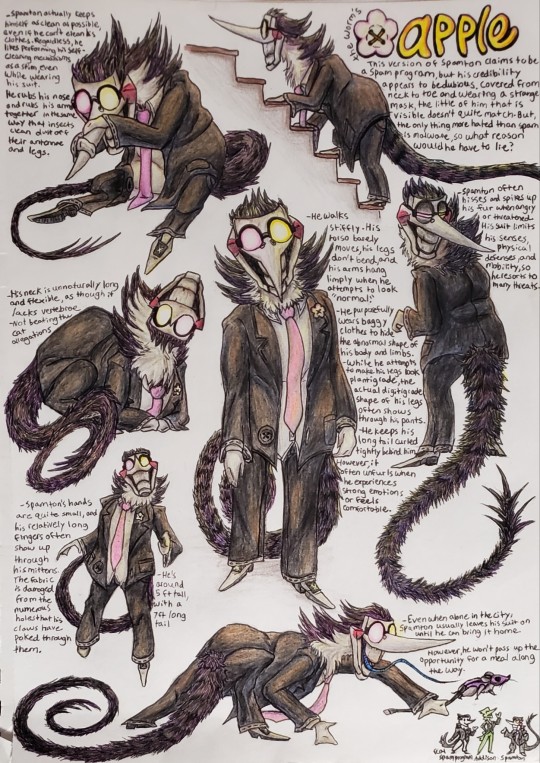
The Worm's Apple
(Spamton AU reference sheet) 1 2
Text ver and close ups below

This version of Spamton claims to be a spam program, but his credibility appears to be dubious. Covered from neck to toe and wearing a strange mask, the little of him that is visible doesn't quite match. But, the only thing more hated than spam is malware, so what reason would he have to lie?

- He walks stiffly. His torso barely moves, his legs don't bend, and his arms hang limply when he attempts to look normal.
- He purposefully wears baggy clothes to hide the abnormal shape of his body and limbs.
- While he attempts to make his legs look plantigrade, the actual digitigrade shape of his legs often shows through his pants.
- He keeps his long tail curled tightly behind him. However, it often unfurls when he experiences strong emotions or feels comfortable.

- His neck is unnaturally long and flexible, as though it lacks vertebrae.
- Not beating the cat allegations
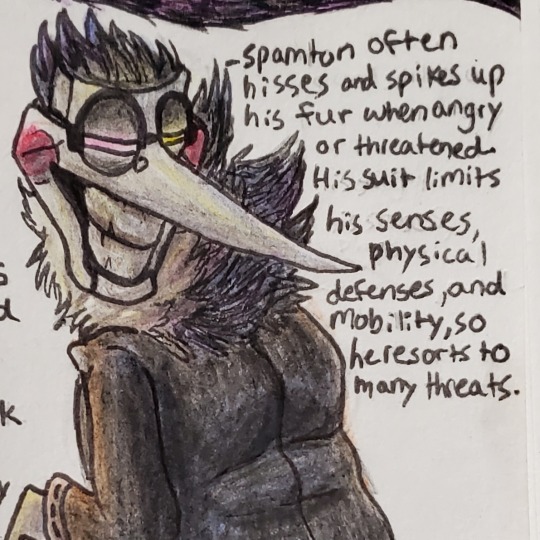
- Spamton often hisses and spikes up his fur when angry or threatened. His suit limits his senses, physical defenses, and mobility, so he resorts to many threats.
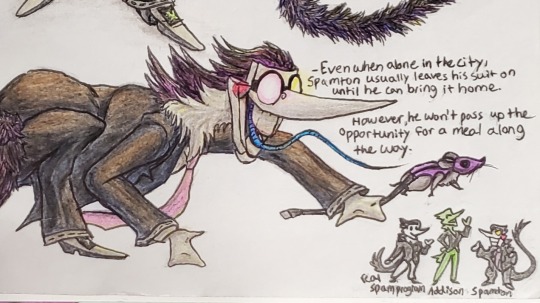
- Even when alone in the city, Spamton usually leaves his suit on until he can bring it home. However, he won't pass up the opportunity for a meal along the way.
- (Tiny comparison of a real spam program, an addison, and Spamton in the bottom right corner)
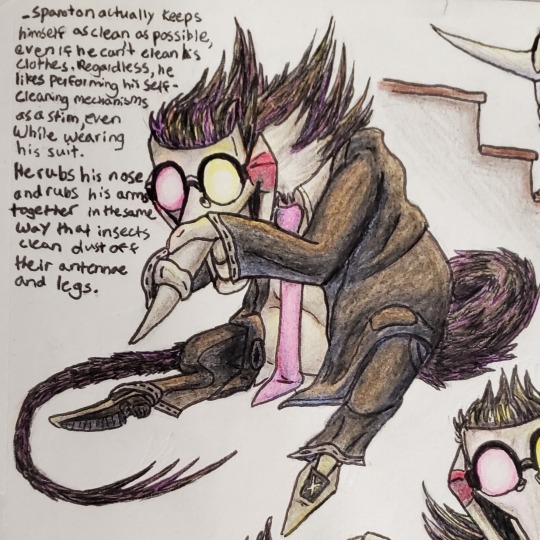
- Spamton actually keeps himself as clean as possible, even if he can't clean his clothes. Regardless, he likes performing his self cleaning mechanisms as a stim, even while wearing his suit. He rubs his nose and rubs his arms together in the same way that insects clean dust off their antennae and legs.

- Spamton's hands are quite small, and his relatively long fingers often show up through his mittens. The fabric is damaged from the numerous holes that his claws have poked through them.
- He's around 5 ft (~150 cm) tall, with a 7ft (~215 cm) long tail
-----
I'm no character designer (Spamton's suit here is literally just the miniature outfit I made for my spam plush), but I like what Disguised Wormton has become over the past two years. While completely accidental, the five-petal shape and yellow thread of his button/pin perfectly represents an apple tree blossom, a nod to his symbolism. The rest of his attempt at an outfit is "hide as much as possible, but still look good doing it." ...as good as he thinks an untucked shirt and clothes ten sizes too big look. He's meant to appear incredibly uncanny when he puts effort into "being normal," looking more like a shuffling zombie than anything natural. I think the round and wide shapes of his suit contrasted with the long, thin, and sharp points of his only visible features adds to the untrustworthness he radiates. His animalistic tendencies look worse when performed by something trying to look humanoid. Even if it's more comfortable for him, the incorrect bend of his legs, the perpetual raptor arms, the absurdly long tail, and his awkwardly long neck highlight the concept of something trying so hard to look human (or humanoid in the case of Deltarune) yet always failing. That's what I was going for when designing him, at least. After writing like 50k words about disguised Wormton, he honestly might be creepier than normal Wormton. I'd rather deal with the obscure cryptid that hisses and runs away than be approached by this kidney stealer lookin mf trying to sell used cigarettes or something. He's definitely grown on me, though. In a "I would never want to be locked in a room with any of the characters I like" kind of way.
#spamton#spamton fanart#deltarune#deltarune chapter 2#deltarune fanart#spamton g spamton#spamton au#wormton au#cheesycatz art posts#how did this guy pull an entire friend group of well adjusted addisons when he looks like this
104 notes
·
View notes
Photo
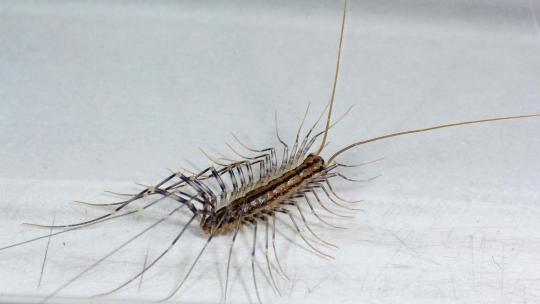
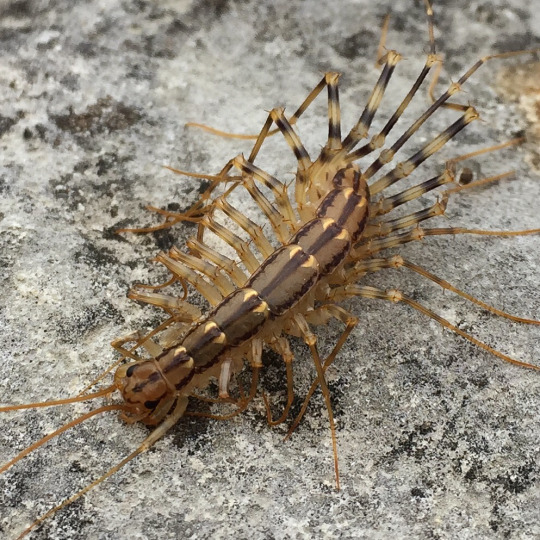
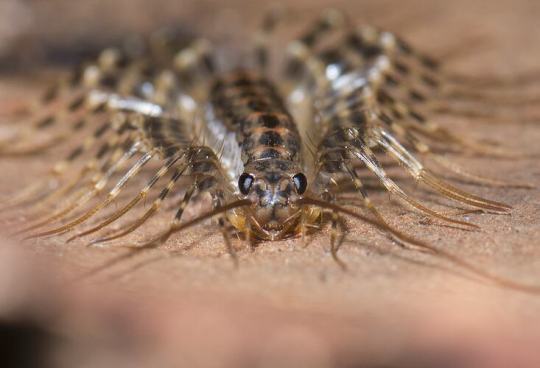
Open Your Home to the Common House Centipede
A common sight in homes throughout Europe, Asia, the Americas, and Australia the common house centipede (Scutigera coleoptrata) is a medium-sized species of centipede originally from the Mediterranean. In the wild, they prefer grasslands and deciduous forests where they can hide under rocks, logs, or leaf litter. These insects have also adapted well to urban development, and are frequently found in basements, bathrooms, and garages, as well as gardens and compost piles.
Like other centipedes, the common house centipede has less than 100 legs; in fact, they only have 15 pairs, with the front pair used only for holding prey or fending off threats. All those legs let the common house centipede move up to 0.4 meters per second (1.3 ft/s) over a variety of surfaces, including walls and ceilings. The actual body of S. coleoptrata is only 25 to 35 mm (1.0 to 1.4 in) long, but the antennae are often as long as the body which can give this insect a much larger appearance. However, they can be hard to spot, especially in their natural environments; their tan and dark brown coloration allows them to blend in seamlessly to surrounding vegetation.
Though they pose little threat to humans, house centipedes are predatory. Their primary food source is other arthropods, including cockroaches, silverfish, bed bugs, ticks, ants, and insect larvae. S. coleoptrata is a nocturnal hunter, and uses its long antennae to track scents and tactile information. Their compound eyes, unusual for centipede species, can distinguish daylight and ultraviolet light but is generally used as a secondary sensory organ. When they do find prey, house centipedes inject a venom which can be lethal in smaller organisms, but is largely harmless to larger animals. This makes them important pest controllers. In the wild, house centipedes are the common prey of rodents, amphibians, birds, and other insects.
The mating season for S. coleoptrata begins in the spring, when males and females release pheromones that they can use to find each other. Once located, the male spins a silk pad in which he places his sperm for the female to collect. She then lays fertilized eggs in warm, moist soil in clutches of 60-150. These eggs incubate for about a month, and the young emerge with only four pairs of legs. Over the next three years, juvenile house centipedes molt 7 times, each time gaining new pairs of legs. After they grow their last pair of legs, immature house centipedes molt an additional 3 times, at which time they become sexually mature. If they can avoid predation, individuals can live up to 7 years in the wild.
Conservation status: The common house centipede has not been evaluated by the IUCN, as it is relatively common both in the wild and in urban areas. Although they have been introduced to areas outside their native range, no detrimental environmental effects have been associated with their spread.
If you like what I do, consider leaving a tip or buying me a ko-fi!
Photos
Joseph Berger
David Paul
Conrad Altman via iNaturalist
#common house centipede#Scutigeromorpha#Scutigeridae#centipedes#myriapoda#myriapods#insects#arthropods#deciduous forests#deciduous forest arthropods#grasslands#grassland arthropods#urban fauna#urban arthropods#europe#north america#south america#asia#australia#oceania#animal facts#zoology#biology
625 notes
·
View notes
Text


Venetiaan vs. Riester fashion🌷
(ft. model Yeseo and Cédric's imagination~)
Additional notes! :D
Venetiaan fashion:
Inspired by 16th-century Western aristocratic clothing (as confirmed by Sookym). Supporting that, both Losna and Werner have been shown wearing furs and robes!
Round cheongsam-like collars
Wide and flowy sleeves/arms/silhouette
Buttons are distinct from Riester's
Riester fashion:
19th?-century inspired
Suits, vests, button-ups! Neckties are in style since the collars permits it, unlike Venetiaan's high and round collars
Typically slim silhouettes for men (with the exception of cloaks and tailcoats)
(Honestly I just think of it as the typical RoFan webtoon visual fashion LMFAO)
This is just my interpretation haha, it's sorta what I gathered from the info given by Sookym in both in-novel and their notes! Distinct fashion/culture between Venetiaan and Riester has always been interesting to me, especially since Jesse (and Johann) have been noted to switch clothing styles once they become more concretely affiliated with the Riester Empire. (I tried giving Jesse more colourful/darker attires for his Venetiaan wardrobe like in my references pics, but his palette works best with whites/light colours so I couldn't bring myself to do it wkdhdkdksk)
When we first meet Johann, he is distinctly from Venetiaan, wearning its clothing and even greeting Jesse, the prince from said country, as "Your Highness" (which is what people from Riester call Cédric) rather than "prince-nim" (which is what they call Jesse, and what Jesse calls Cédric), displaying his nationality and the royal family whom he serves. He only begins dressing like a citizen of the Empire once he pledges his life and abilities to serve Empress Frédérique and become one of her people!
And as for Yeseo, he only begins to be dressed by his attendants in the attire of the Empire following his 'resurrection', and we can see more of this sort of shift when he goes from being addressed less as "prince-nim", and more as (마마—) "gungju-nim" (palace lord). There's also him eventually being referred to as the Moon of the Empire, instead of the Moon of the Holy Kingdom 🥹
I'm really fond of the webtoon because if there's one thing it does right, it is absolutely how it captures the lighthearted charm, atmosphere, and vibe of the original novel—though one thing im lowkey sad about is that the visual distinction between Venetiaan and Riester culture via clothing seems to have been lost :') It's a small detail on the surface, but it's actually a pretty significant and symbolic shift when Jesse gradually begins to be dressed less like "Prince Jesse Venetiaan", and more as "Marquis de Sérénité of Riester", the Palace Lord of Juliette :')) But of course, making a webtoon is hard work and I still immensely appreciate the artist's work nonetheless (btw I am eternally grateful for them giving Yeseo an ahoge/hair antenna, it is GENIUS chara design and so so so very cute, i love webtoon jesse so much hahajhsjh)
#when the third wheel strikes back#서브 남주가 파업하면 생기는 일#twsb#섭남파업#jesse venetiaan#jung yeseo#cédric riester#cedjess#cedyes#twsb fanart#my art#venetiaan holy kingdom culture#riester empire culture#i love how sookym portrays the cultural differences between the two countries
744 notes
·
View notes
Text

Abandoned hotel

North Korea 🇰🇵

It was supposed to become the world's tallest hotel. Instead, it became the world's tallest abandoned building. The pyramid-shaped Ryugyong Hotel is 330 metres (1,080 ft) tall and one of the most prominent features of Pyongyang's skyline. The structure consists of 105 floors and it was originally intended to house five revolving restaurants, and between 3,000 to 7,665 guest rooms
Construction began in 1987 and it was North Korea's response to other high-rise development taking place in cities around the West and Asia during the Cold War. For North Korean leadership, it was also an attempt to bring western investors into the marketplace. The hotel was scheduled to open in June 1989 for the 13th World Festival of Youth and Students, but problems with building methods and materials delayed completion.
In 1992, after it reached its architectural height, construction halted due to the economic crisis and famine in North Korea following the collapse of the Soviet bloc. By then, the hotel's construction cost $750 million, consuming 2% of North Korea's GDP. For over a decade, the unfinished building sat vacant and without windows, fixtures, or fittings, appearing as a massive concrete shell while A rusting construction crane remained at the top.
In 2008, construction resumed by the Egyptian Orascom company. The company had also made a deal to operate North Korea's telecommunications network and installed antennas on top of the building. By 2011 work had finished. Ryogyong Hotel was fitted with windows but not much work had taken place in the hotel's interior. Since then, there have been many rumors of the hotel finally opening but until today it remains unoccupied.
#urban decay#abandoned#urban exploration#urbex#urban nature#remnants#urban photography#ruins#apocalypse#apocalyptic#dystopia#dystopian#postapocalypse#postapo#postapocalyptic#postapoc#wasteland#wastelands#fallout#postnuclear#scifi#fantasy#art#doomsday#preppers#doomsday preppers#bugoutbag#architecture#aesthetic#north korea
127 notes
·
View notes
Text
There are some animals that, if they didn't exist and somebody made them up, we would say they had an overactive imagination. The bobbit worm is one of those creatures, the closest we have to a real-life Mongolian death worm. So for this Wet Beast Wednesday, I'll tell you about just how weird it is.
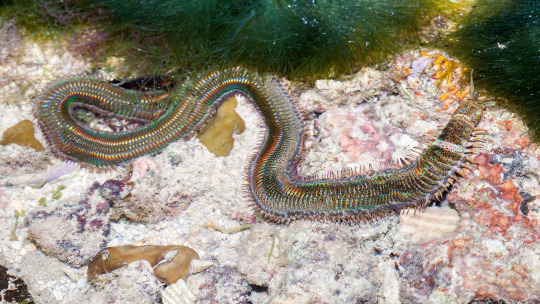
(image: a rare full-body shot of a bobbit worm)
Before we start, I want to go on a brief tangent. What exactly is a worm? Well it turns out that like fish, worms aren't real. At least they aren't from a taxonomist's perspective. In common parlance, we refer to any long, skinny, and (usually) legless invertebrate as a worm. In taxonomy, that is far too broad of a category, especially as lots of animal lineages would have started out as something a lot like a worm and you can't stop being what your evolutionary ancestors were. Instead, taxonomists classify worms into multiple distinct phyla that independently converged onto the worm body plan, including the platyhelminths, nematodes, nemerteans, and annelids. The bobbit worm (Eunice aphroditos) is an annelid, which are known for their multiple body segments. More specifically, it is a polychaete or bristle worm, which are known for having a pair of fleshy protrusions called parapodia on each body segment, which have chitinous bristles called chaetae growing from them. There is some debate that the bobbit worm may actually be a species complex, which is when multiple related species are mistakenly classified as a single species.
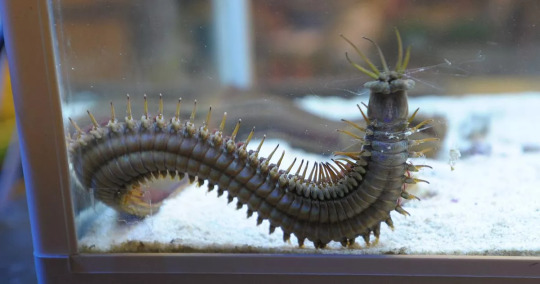
(image: a bobbit worm found in an aquarium)
Bobbit worms are the largest of the polychaetes, with the largest known specimen being 299 cm (9.81 ft) long. They are also rather skinny, usually reaching no more than 2.5 cm (1 in) wide. Bobbit worms have a wide range of coloration, ranging from brown to black and often with a rainbow of other colors going down their bodies. You might not notice this, however, because they spend most of their time burrowing under the sand in their Indo-Pacific coral reef habitats. This provides protection from predators and is important to their hunting strategy. Bobbit worms will stick their heads out of the sand and wait while their 5 antennae use chemosensitive and light-sensing cells to detect when fish pass by. When a fish comes too close, the worm strikes. They use a set of retractable jaws that are razor sharp and come together like scissors to bite the fish. This bit is strong enough to cut small fish in half. It is rumored that this is the source of their name, from the Lorena Bobbit case. I will not elaborate further, google it if you don't know. Those fish that are not killed immediately will find themselves bleeding out and paralyzed from venom injected through the jaws as they are dragged into the worm's burrow to be eaten. There are some reports that the wom's chaetae are also venomous and that handling them barehanded can cause permenent numbness, but this does not appear to be the scientific consensus. The worms will also feed on seaweed and other algae, making them omnivorous.
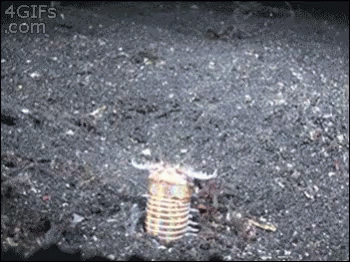
(gif: a bobbit worm catching a fish)
The borrows made by bobbit worms are dug out of the sediment and coated with mucus. The worm uses its chaetae to move in and out of the burrow. The mucus if filled with nutrients that bacteria, particularly sulfate-reducing bacteria, absolutely love. This allows iron sulfides to accumulate in the mucus. When exposed to oxygen in the water, usually at the opening of the burrow, the sulfides will become iron hydroxides. These help reinforce the burrow's opening. Bobbit worms rarely leave their burrows and will retreat at the first sign of danger, making it very hard to spot them in the wild. Several fossilized burrows have been found, one dating to 20 million years ago. Another burrow of a similar animal, possibly an ancient relative of the bobbits, was found dating to 400 millions years ago.
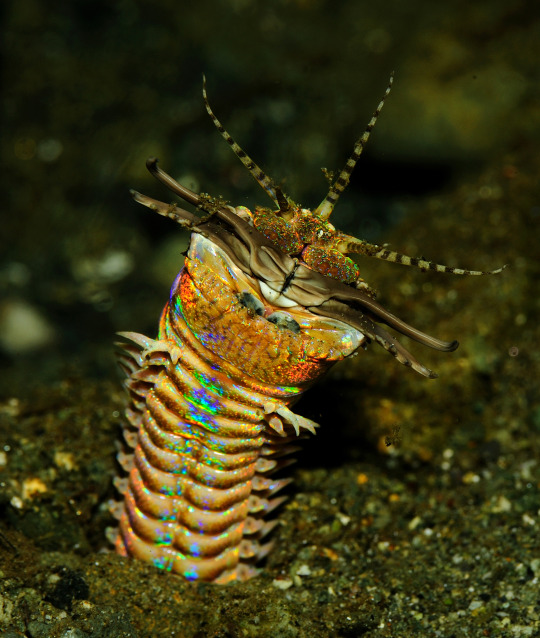
(image: a bobbit worm head with jaws extended)
Bobbit worms reproduce externally. At night, a female will emerge from her burrow and release pheromones that attract males. She will then release her eggs into the water. The males will follow by releasing sperm, allowing for fertilizations. The majority of larvae will die before reaching adulthood. There are rumors that females withh bite off the male's genitals to feed to her young, but this is not true. Bobbit worms can also reproduce asexually by splitting. When handles, a bobbit worm can split itself into multiple sections, each of which can grow into another identical worm. This is a common adaptation in polychaetes as it allows them to survive if a part of them is eaten.
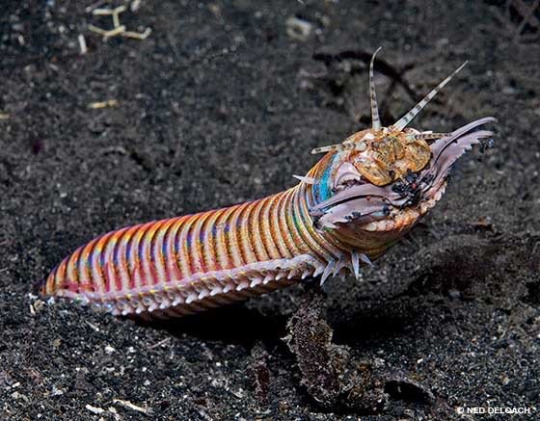
(image: a bobbit worm just sitting there, menacingly)
Bobbit worms have become a nuisance species in aquariums. They are usually introduced as tiny larvae clinging to rocks brought in for decoration or shelter. Once in an aquarium, the worms can grow rapidly and will eat any fish in the tank. Removing them can be very difficult due to their size, regenerative abilities, and reclusive nature. One famous case that introduced a lot of the internet to the worms was that of the Newquay aquarium in England. Aquarium staff were confused when a lot of the fish were vanishing from one tank and the coral was damaged. They tried laying traps, but the intruder ate the fishhooks they used and could bite through 20 lb fishing line. Finally, they lured it out with food, finding a 4 foot long bobbit worm that they named Barry. Barry became a hit online and was moved to his own tank. There apparently were plans to put him on exhibit, but I can't find confirmation that this ever happened. Given that this happened in 2009 and the bobbit worm lifespan is 3-5 years, I am sorry to tell you that Barry has passed away. RIP, king.
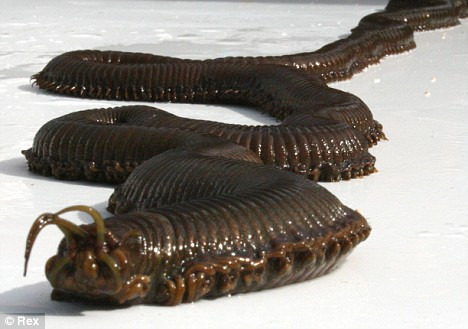
(image: Barry after being removed from the tank. His drab color is thought to be the result of poor nutrition)
Because of how reclusive they are, bobbit worms are an understudied species. Attempts to raise them in laboratories have mostly failed, so there is a lot we don't know about their reproduction, development, and behavior. We also don't know if they need any conservation efforts.
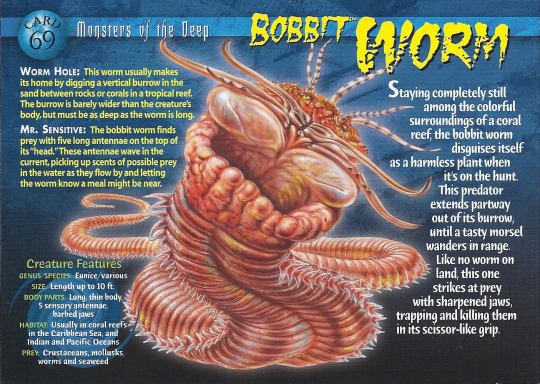
How many times in this series am I going to be able to use cards from this series? (image: the bobbit worm card from Weird n' Wild Creatures)
#wet beast wednesday#marine biology#biology#zoology#bobbit worm#animal facts#worm#annelids#polychaete#images#barry the bobbit worm#late again#forgot to prep a post
373 notes
·
View notes
Text

some silly dragon headshots ft some headcanons below the cut
mudwings: not too much going on here, i think while most tribes can have ram type horns its most common in mudwings to have horns resembling sheep of some kind. not pictured here but some might have tusks. they have ears that stand up to poke out of the mud when theyre hiding in it so they can hear whats around them
seawings: sloped heads w no real break between it and the snout. to reduce drag! i also think seawings wouldnt have dangly earrings just in case it gets caught on something underwater. thats it lol. some can also have whiskers
skywings: no thoughts european dragons only. theyre spikey. second spikeyest dragons. theyre drawn here more detailed than i would draw them normally though
sandwings: big ears for heat distribution!!! they dont always stand up but its not at all uncommon.
rainwings: its basically just book rainwings idk what you want from me. i think they can have frills more than just around their ears but its by far the most common place
icewings: pointy pointy pointy. their ears can never be floppy also theyre ALWAYS pointing outward. also their chins have spikes
nightwings: just like in book nightwings lol. no comments here really. seers have a silver scale on their forehead maybe idk i go back and forth on that
silkwings: they have two main variants, one standard and one based on moths. moth silkwing are fluffy and have antennae and tend to be more desaturated colors. the difference is mostly cosmetic, though moth silkwings DO have weird sleep schedules sometimes
hivewings: nothing to say here at all actually. theyre book hivewings
leafwings: same here
#doodles#wings of fire#mudwing#seawing#skywing#sandwing#rainwing#icewing#nightwing#silkwing#hivewing#leafwing
53 notes
·
View notes
Text

Thrikreen, insect people! Traditionally these are 4–7 ft (1.2–2.1 m) tall, though the AAG says they can go a little smaller. They've got 4 arms, change color at will, see in the dark, don't need to sleep (only sit down and rest for a bit), and are telepathic! You don't even need to share a language, it just interacts with your base understanding. Which is good, the mandibles make speaking our languages difficult, and we struggle to speak a language that's as much antenna waving as it is sound. They're nomadic hunters that form a group of a couple people they trust and are extremely antisocial toward everyone else, though they hide that distrustful side since unnecessary conflict is dangerous.
Edit: We're talking about the player character version, which live normal human lifespans. The original version only lives around 25 years. Bit weird, but they smoothed out all the short lived species the same way they made many have multiple size options or different creature types.
51 notes
·
View notes
Text


i recently learned to love homestuck again and fell in love with their sibling franchise hiveswap. I've gotten obsessed with drawing full-bodies of these characters and decided to redesign some of them with unique features! ✨
here is kuprum maxlol from hiveswap ⚡ i just finished this guy and hope i can keep drawing more! it features my friend @crow-cello's version of sollux for better reference of the bee biology we have for the goldbloods 🐝 maybe eventually i can work up a reference sheet to better illustrate the differences between our bees!
i rewrote all of the info on Kuprum's reference sheet under the cut in case my handwriting is hard to read 🙈
KUPRUM MAXLOL (GOLDBLOOD, DRONE BEE)
6'2 ft (187.96 cm)
PSIONIC POWERS. Streams of electricity that discharge from his palms, but exist throughout his entire body. Comes out yellow on his right and purple on his left.
GOGGLES. Fuschia colored. Lens are yellow (his right) and purple (his left). Always wears them because his eyes are aglow.
ATTIRE. Has to tie shirt around the neck and lower back like an apron. Gives wings breathing room. Wears shorts that grip at the bee's knees. Arms warmers instead of long-sleeved undershirt. Does not wear footwear.
BODY. Goldbloods are bee-like trolls. There are worker bees ♀️ and drone bees ♂️. Both have different features. Kuprum is a drone bee!
ANTENNA. Feelers that can learn the biology of another via touch
MANDIBLES. Mandibles on either side. Spreads apart as his lips move. Only exists in drone bees.
FLUFF. Has fluff around neck. Drone bees fluff is yellow. Worker bees fluff is black.
HAIR.
HORNS. Two sets. Gradients instead of candy corn.
EYES. His right eye is yellow. His left eye is purple. Appears white because of how bright his eyes are.
WINGS. Sprouted on upper back. Does not work.
LEGS. Has bee-like legs starting from the bee's knees. Helps him climb and crawl around better.
SOLLUX CAPTOR. Worker bee (trans male) Has bee butt and smaller features.
#hiveswap#hivesmut#kuprum maxlol#sollux captor#my art#fanart#art#yessss i posted this on the holy day of 4/20. blaze it my guys#i opted for a cuter yellow because i dont like how grungy their original yellow is-#fullbody reference sheets
38 notes
·
View notes
Photo

Every six months Kevin Schmidt, of South Dakota climbs this 457/m (about 1500 ft.) high KDLT-TV antenna communication tower to change the light bulb. He’s paid $20,000 per climb.

I feel weak just looking at this.

This was captured by drone. He makes his ascent precisely and steadily, clipping his safety gear to the tower as he goes.

Once he's conquered his incredible climb, he pauses for a well-deserved selfie at the peak
https://www.dailymail.co.uk/news/article-2896320/The-vertigo-inducing-moment-daredevil-climbs-1-500-feet-change-lightbulb-atop-TV-tower-
402 notes
·
View notes
Text
Moth of the Week
Garden Tiger Moth
Arctia caja

The garden tiger moth or great tiger moth is a moth of the family Erebidae. They were first described in 1758 by Charles Linnaeus. The caterpillars are known as “woolly bears.”
Description The forewings of this moth are brown with white patterning. This white pattern can be missing entirely. The hindwings are orange with black dots which also may vary from moth to moth due to chance and artificial reasons. French entomologist Charles Oberthür discovered about 500 different variation in patterns.
The patterns on the moth’s wings warn predators that they are toxic. The toxin in this species in part contains neurotoxic choline esters which interfere with the acetylcholine receptor.
The head is lined with red over dark brown and has white antennae while the thorax is a matching dark brown. The abdomen matches the hindwings with bright orange fur and black stripes.
Wingspan Range: 45 - 65 mm (1.8 to 2.6 in)
Diet and Habitat This species are called generalists, meaning they eat a wide variety of plants. That are known to eat plants in the Digitalis and Plantago genuses. These plants produce pyrrolizidine alkaloids, a common chemical that causes toxicity in moths. Adult moths eat nectar from flowers and have no observed preference.
They range from the northern United States and Canada to Europe and Northern and Central Asia. In Europe, it goes north until Lapland. They prefer cold, temperate climates and are found in the mountains of Tien Shan (up to an elevation of 3,000 m (9,800 ft)), grasslands, sand dunes, meadows, woodland edges, hedgerows, gardens, and forests. Because this species are generalists in diet, they are not confined to one habitat due to host plant locations.
Mating Females lay around 50 eggs on the underside of host plant leaves. Eggs hatch from August to September when the former generation has died. It has been observed that generations do not overlap.
Predators Adult moths use their wing patterns and colors to warn predators that they are inedible. Their diet allows them to gain toxins including neurotoxic choline esters which interfere with the acetylcholine receptor. The full effects of the toxins are not known. The adults are mostly preyed on by birds and bats. Another way the adults protect themselves from bats is to make noise with their wings which interferes with the bats’ behaviors.
However, several species of endoparasitic flies prey on the species as larva. These include: Carcelia gnava, Carcelia lucorum, Carcelia tibialis, Compsilura concinnata, Exorista fasciatax Exorista grandis, Hubneria affinis, Pales pavida, Thelaira leucozona, Thelaira nigripes, and Thelymorpha marmorata.
The larvas’ defense against outside forces is stinging hairs that cause hives and irritation in mammals, including humans. These hairs are not fatal.
Fun Fact The garden tiger moth has been a protected species since 2007 by the Biodiversity Action Plan in the United Kingdom.
(Source: Wikipedia, Butterfly Conservation, Moth Identification)
#libraryofmoths#animals#bugs#facts#insects#moth#mothoftheweek#lepidoptera#Erebidae#garden tiger moth#great tiger moth#Arctia caja
147 notes
·
View notes
Text


@wrylu *squeeze you like those squishy balls but your antennas? (ears?) squeak out instead of the eyes* ft. drawing your cowbug sona from memory
peek a boo a wip of ya boi vincent that i be struggling with

12 notes
·
View notes
Text

Peacock Mantis Shrimp (Odontodactylus scyllarus)
Habitat & Distribution
Generally resides in coral reefs and sandy flats, at depths up to 3 m (9.8 ft)
Found throughout the Indo-Pacific, from the eastern coast of Africa to the Phillipines
Physical Description
Weight: 12-90 g (0.4-3.2 oz)
Length: 10-38 cm (4-15 in)
Peacock mantis shrimp are extremely colourful; the main shell is mottled green and blue, and the legs are red
On either side of the head are large, green, fan-like structures called antennae scales, and the head itself is blue with purple eyes
Behaviour
Peacock mantis shrimp hunt their prey by ambush, and use their powerful claws to smash the shells of mollusks and crustaceans
They reside in underground burrows, which they defend fiercely
Peacock mantis shrimp can be prey for large fish, cuttlefish, squid and octopus
Key Advantages
The peacock mantis shrimp has an extremely fast punch, reaching speeds of 80 kph (50 mph); its limb accelerates at 100,000 m/s2 (330,000 ft/s2) which creates momentary bubbles of boiling water
The exterior of their clubs are made of hydroxyapatite, an extremely hard and dense material
They can swim at speeds of up to 1 m/s (3.2 ft/s)
Photo by Cédric Péneau
139 notes
·
View notes